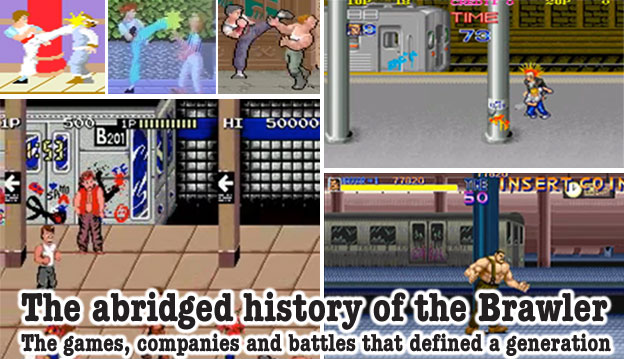
IGS, the indy studio that could, released The Gladiator aka The Road of Sword in 2003. This was the last sprite based brawler in the arcade that was worth a damn The quality of the title was head and shoulders above the half-hearted efforts from other small publishers over the past few years. The character designs, levels and animations were on par with the best from Capcom and Konami during their peak. When new filters, more colors, animations and effects were rendered thanks to the more powerful graphics engine, then Gladiator actually appeared to be even better than brawlers from the big publishers.
Like previous IGS titles it was set in an Eastern mythology world. The archetypes were pulled from classical legends but stylistically updated for modern audiences. The game was very much in the vein of the Capcom Dungeons and Dragons titles. It allowed players to choose which of three paths they would take to reach an evil warlord, but unlike the D&D games there were no shops to purchase upgrades to the characters. The game had a level-up system which affected the speed, strength and special moves of the characters, the more battle points a character earned the more techniques they could perform in game. The title even provided a complex brawling engine. A player could select automatic combos so that all they had to do was press the same attack button over and over to do multiple hits, or advanced players could manually enter the commands and perform a multitude of attacks and special moves that would be the envy of many fighting games. Players that worked well together soon learned that they could activate a special attack simultaneously to get special animations and even more powerful attacks to bring down bosses.
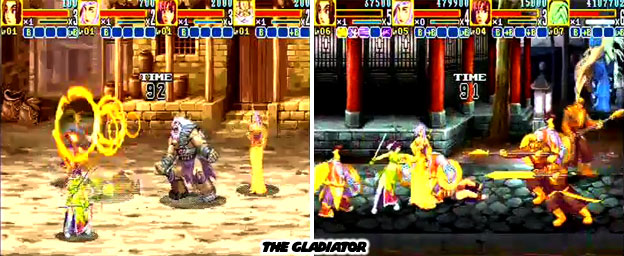
The game was beautiful. The character designs and architecture were not strictly based on one Asian region but reflected a myriad of cultures including Chinese, Mongolian and Korean. IGS was clever with this approach as they could localize the game relatively quickly in most Asian countries. I would rank this game up there with Guardian Heroes and then go a step further without sounding sacrilegious and say that it was more important to the industry because it was so rare. An independent studio working on a brawler with archetypes they were familiar with, in a style that was decidedly Asian but not anime’ plus not based on a license, could defy the expectations of gamers. It could inspire an entirely new wave of great design. The Gladiator never saw a console release, nor any English localization to the best of my knowledge. If not for the imported Chinese arcade games in Downtown LA arcades I would have never seen this title, or a couple other IGS gems. For those reasons the Gladiator deserved to get just a little more exposure and the hopes that word would spread and the title might yet find a home on Xbox Live.
By comparison the big publishers were still pushing for the brawler to be in 3D. Sega released Spikeout Battle Street in 2004 for the original Xbox. The title was actually developed by DIMPS. This was the sequel to the rare arcade brawler and actually set years after the earlier SpikeOut titles. The game revolved around a new gang, made up of the next generation of brawlers, including Spike Jr. It was a good way to honor the legacy of the publisher. Spike Jr. was previously seen in SpikeOut Final Edition. He followed his father around and imitated his moves. As he grew up he gained a style all his own. Players could actually unlock the original team in the game and have father and son fight side-by-side like the good old days. The game was unique because it provided access to the Sega battle network so players could enjoy competing online.
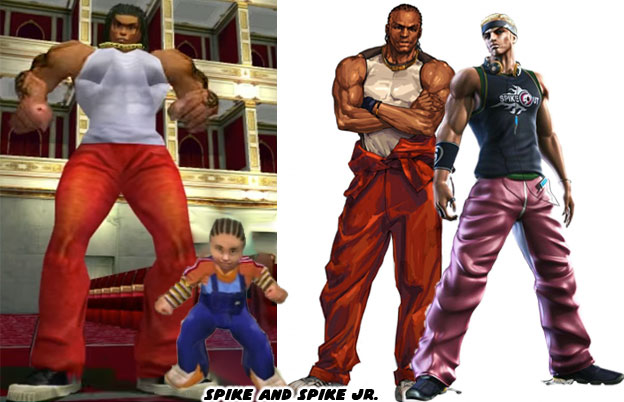
Battle Street was a fun title that rekindled the magic of the original SpikeOut but at the same time could prove to be difficult if you didn’t know the nuances of 3D brawling. Players that tried this game and didn’t have some experience playing games like Virtua Fighter, Fighting Vipers or the earlier SpikeOut would be at a loss The genre was difficult to get into and master once it had moved to 3D Yes Double Dragon and the other classics could be difficult but gamers could pick up techniques and strategies quickly. Once the format had moved to 3D the experience became exponentially more difficult but not exponentially more rewarding. Opponents were harder to defeat and they came in wave after wave, striking at blind spots and eating up the health and patience of gamers. Players were eager to find more rewarding brawling experiences. They looked at the young publisher to try and deliver that.
Demolish Fist was developed by Sammy and DIMPS in 2003. Sammy had developed the Atomiswave arcade hardware which featured interchangeable carts, similar to SNK's Neo Geo and IGS's PGM. The hardware was so well done that SNK used it to power the King of Fighters XI, Samurai Showdow VI and Metal Slug 6 games. Their main developer, DIMPS, was made up of former Capcom and reportedly SNK employees. Their flagship fighting game Guilty Gear had caught the attention of the community. Guilty Gear used HD sprites and brilliant 3D backgrounds. With Demolish Fist they were trying to rewrite the 3D brawler. The game featured a quartet of typical Japanese street designs, cool-looking androgynous guys similar to the Bouncer from Squaresoft. The engine was 3D but the camera was a traditional fixed side-scrolling perspective. Just because the camera was fixed it did not mean the characters could only face left or right, players were free to fight in a full 360 degrees.
The designs of the heroes and villains looked very typical and bland. Some thugs with helmets were pulled right from the Hokuto No Ken / Fist of the North Star comics. The animations seemed stiff and sluggish and the fighting mechanics were insipid. Demolish Fist was the complete opposite of the Guilty Gear. The combat was poorly paced and characters could perform feats of superhuman strength, like lifting and throwing motorcycles and cars with ease. It made little sense that they could be harmed by a punch or kick from anything less than a gigantic robot. The one redeeming gameplay element that it did introduce was the "Vertigo" mode. Characters could power up a separate energy bar and then activate the Vertigo attack which sped up the player and moved them automatically between opponents. All a player had to do was press attack quickly while in this mode. The computer would automatically target the nearest opponents and throw punches and kicks between them in rapid succession. The Vertigo mode was not unlike the fighting mechanic given to the Flash in the Justice League Heroes. It looked impressive and made players wish that all 3D brawlers could be as simple to control.
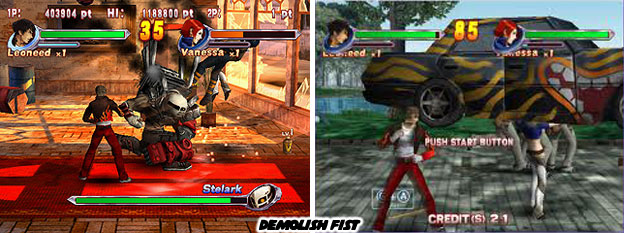
Unfortunately there was little else in Demolish Fist to bring new fans to the genre. The title was still important for the the developers. The experience working with 2D and 3D technology, techniques and gameplay would be merged a year later. The fighting game, the Rumble Fish, released in 2004 used rotoscoped 3D models to build 2D sprites. It kept the pacing from Guilty Gear but updated the techniques used to build sprites based on the models they had created for Demolish Fist. These lessons of combining 2D and 3D elements would find their greatest success a few years later when DIMPS was tapped by Capcom to develop Street Fighter IV. Before Capcom had even conceived Street Fighter IV however they had tried to bring the brawler into 3D. Their first attempt was a well done but little known title.
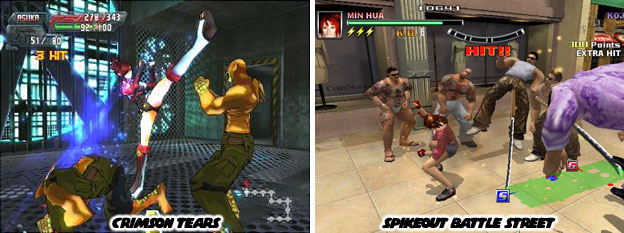
Crimson Tears, another 2004 title was a sci-fi, cel-shaded, rpg brawler featuring three humanoids, err “mutanoids” named Katie, Amber and Tokio. Since the game was set in the future the grinding system was set inside of giant corporate towers and factories fighting soldiers and robots rather than against monsters inside an evil wizard’s lair.
The game allowed characters to build techniques and master weapons as well as collect items to help get them through levels. Players could trade items and upgrade their stats. Once players had achieved higher levels then the true heart of the combat system could be explored. Players could perform multi-branched combos that allowed them to juggle opponents, or stun them and set up an attack on rivals closing on from the sides or behind. Combos could be as diverse as a player allowed with button presses rather than controller commands. This combo system was easier to get into than even SpikeOut. Other studios would work on comparable fighting mechanics going forward. While Rocksteady studios would like to claim they invented the "freeflow combat system" for its Batman / Arkham games a variation of it was seen in both Demolish Fist and Crimson Tears five years earlier.
Unfortunately Crimson Tears was very repetitive and it took ages for characters to reach their full potential. It is possible that very few players actually took the time to max out their stats and explore the combat engine. That difficulty curve was a missed opportunity for Capcom and developers Spike, of Fire Pro Wrestling fame, to bring the brawler into 3D. The brawler was experiencing growing pains through the new millennium. Having been taken out of the arcade, put on consoles and made into 3D did nothing to improve the experience. The next blog will look at Capcom's attempts to reinvent the experience for a new generation of console players. As always if you enjoyed this blog and would like to sponsor me please visit my Patreon page and consider donating each month, even as little as $1 would help make better blogs and even podcasts!

No comments:
Post a Comment